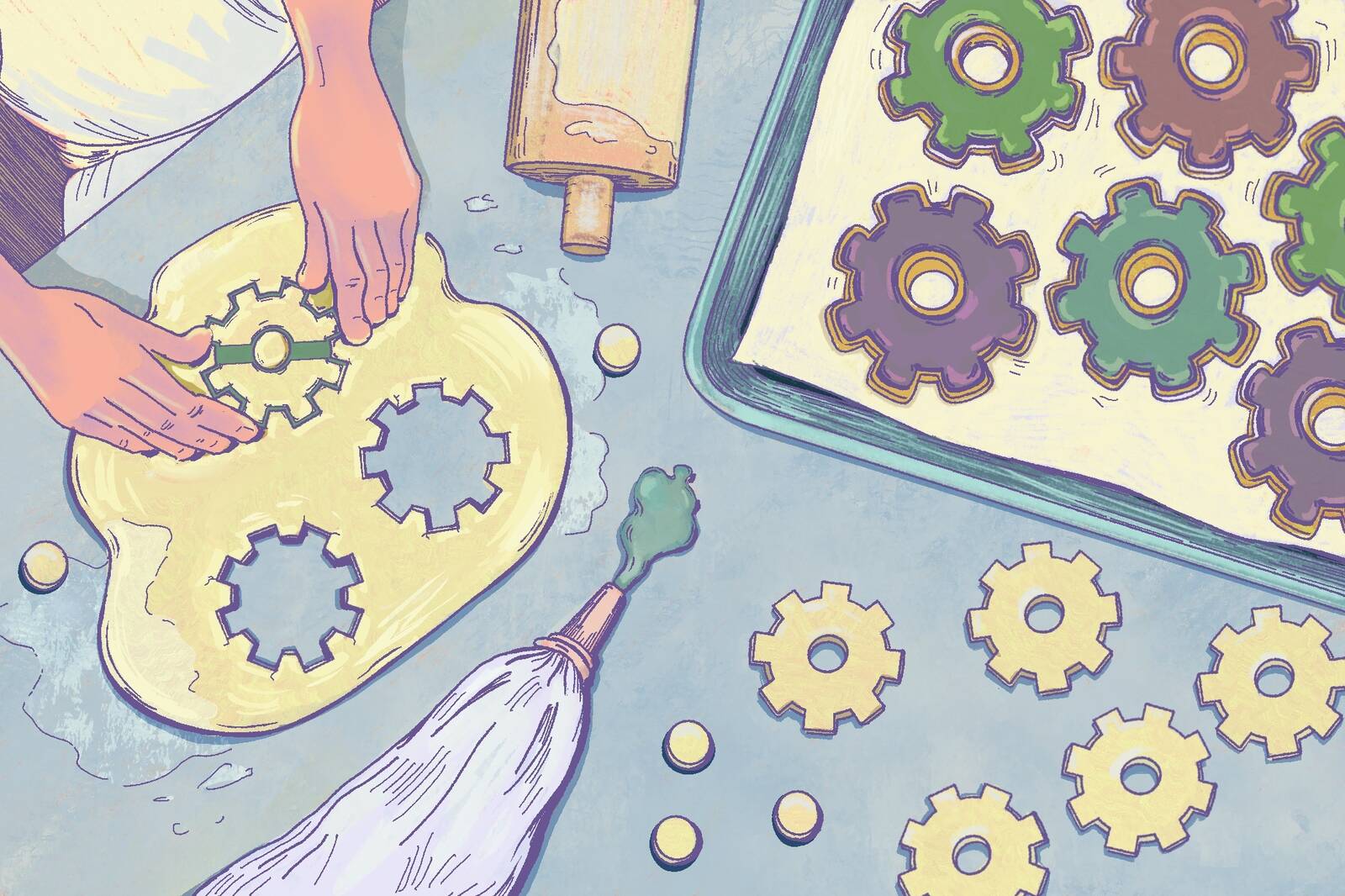Strategy Nov 11, 2025
The Growth Factor Fueling Industry Behemoths
Standardizing production has helped massive companies like IKEA, Starbucks, and Coca-Cola outscale their competitors.

Veronica Martinez
Consider a few types of furniture companies: There’s the small artisan firm, where a carpenter builds one-of-a-kind armoires and cabinets. There’s the medium-sized chain like Crate & Barrel, with about 100 stores in North America and a sprinkling of international locations.
And then there’s IKEA.
Since its founding in 1943, the Swedish furniture behemoth has expanded to 487 locations around the globe. In 2024, the firm reported 45 billion euros in sales and nearly 900 million visitors to its stores—far exceeding the revenue of its competitors.
A similar trend has emerged in many other industries as well. For instance, Starbucks dwarfs mom-and-pop coffee shops, Procter & Gamble dominates detergents, and Coca-Cola and Pepsi are giants in carbonated drinks. “The leader in each of the sectors is just so much bigger,” says Sara Moreira, an associate professor of strategy at Kellogg.
Moreira wondered how these companies came to be so huge compared with other firms in the same product category. She collaborated with David Argente at the Yale School of Management, Ezra Oberfield at Cornell University, and Venky Venkateswaran at New York University’s Leonard N. Stern School of Business to investigate the potential driving forces behind the rise of these mega-firms.
Through mathematical modeling and an analysis of data on firms in the consumer-packaged-goods industry, the researchers found that a key factor propelling the firms’ growth has been standardization: the degree to which a company reuses components, knowledge, and relationships across different product lines and locations.
In IKEA’s case, it became famous for using similar parts and materials for various types of furniture. Similarly, Starbucks has relied on tried-and-true formulas for floor plans, menus, and barista training to efficiently open more locations.
This standardization has served as a kind of superpower, allowing firms to grow faster and to respond to increased demand more easily and quickly. The resulting snowball effect has led to the emergence of the gargantuan companies we see today. “The bigger they are, the easier it is for them to become bigger,” Moreira says.
The paradox of mega-firms
Traditional economic theory predicts that, as a firm gets bigger, it becomes increasingly difficult for it to grow even larger. At some point, managing and coordinating so many people becomes unwieldy, and bloated teams become less productive.
The emergence of mega-firms like IKEA and Starbucks despite this prediction motivated Moreira and her colleagues to consider factors that traditional economic theory tended to overlook. Examining the effect of standardization would “allow us to explain that there are indeed forces that push firms to be larger than others,” she says.
First, the researchers created a mathematical model to explore how standardization might influence a firm’s growth. In the model, various companies produced different numbers of products, and they could choose how much to standardize features across products.
The model suggested that firms with higher standardization benefited from a chain reaction. When demand increased, those companies didn’t have to spend as much money to create new products because they could reuse existing features. And as their product lines grew, standardization became even more valuable, pushing them to expand further.
“When knowledge, investments, and inputs are potentially scalable, that can allow the firms to become bigger.”
—
Sara Moreira
In other words, these firms could respond more strongly to demand. When customers clamored for new products, the companies could churn them out with relatively little additional effort, allowing the firm to balloon to greater and greater sizes.
Scoring high on standardization
The team then put the model’s predictions to the test. They obtained real-world data on consumer-packaged goods collected from barcode scanners at grocery stores, drugstores, and big-box retailers between 2006 and 2015. The dataset covered more than one million products across multiple categories, such as light bulbs and razors. For each product, the researchers identified several individual attributes, including style, use, material, and packaging.
With these details in hand, the team measured the degree of standardization across products for various manufacturers. They calculated a score for each company that captured how much the firm reused particular attributes across its products. For instance, one attribute in razors might be “pivoting head.” If the same type of head appeared across many razors in the firm’s portfolio, that repetition would boost its standardization score.
Overall, the researchers found that “larger firms reuse characteristics way more,” Moreira says. The finding supports the idea that companies with more products tend to exhibit a higher level of standardization.
Capitalizing on higher demand
Next, the team investigated whether standardization indeed gave larger firms an edge when demand spiked. Were they able to ramp up production more quickly in response? If so, instead of slowing down as traditional theory predicts, “they’re actually growing even more,” she says.
To explore this question, the researchers examined an episode that disrupted many industries between 2006 and 2015. During this period, imports from China to the U.S. were increasing, putting pressure on American firms producing similar goods. This negative “shock” affected the residual demand for U.S. companies and varied substantially across industries. Because of this industry-specific variation, the team could estimate how standardization influences a company’s response to demand shocks while accounting for several confounding factors. As predicted, the researchers found that firms with higher levels of standardization—reflected in their future size, number of products, and standardization—responded more strongly to demand shocks.
A similar pattern emerged when the team analyzed another signal of rising demand: higher housing prices. They gathered data on the locations of firms’ stores—for example, all the coffee shops a chain operated across the country. If home values in a particular area rose, people likely had more wealth, which would increase demand for goods in that region.
The team found that larger firms expanded more than smaller ones when housing prices near their store locations increased, indicating that these companies more-effectively capitalized on the opportunity to serve eager customers in those areas.
Using what you know
By underscoring the role of standardization, the research fills a gap in how economists explain company growth.
“Our traditional models in economics have not been incorporating the importance of standardization,” Moreira says. “When knowledge, investments, and inputs are potentially scalable, that can allow the firms to become bigger.”
For smaller firms aiming to grow, the findings suggest that they could grow faster if they reuse existing materials and expertise when creating a new product, rather than starting from scratch.
Let’s say a company makes healthy organic snacks sold at high-end stores such as Whole Foods. It may not be wise to branch out into a line of snacks where low price is the primary consideration, aimed at customers who shop at Walmart. Since the firm’s employees know how to source organic ingredients and have connections with high-end stores, they could more-easily add, say, organic juices that require less additional effort to roll out. After all, the company has invested considerable time and money into building its existing foundation.
Managers should consider “if they already have a set of inputs, of knowledge, of know-how that will allow them to easily add that,” Moreira says. By reusing components and hard-won knowledge, “it’s less costly to you.”
Roberta Kwok is a freelance science writer in Kirkland, Washington.
Argente, David, Sara Moreira, Ezra Oberfield, and Venky Venkateswaran. 2025. “Scalable Expertise: How Standardization Drives Scale and Scope.” Working paper.



